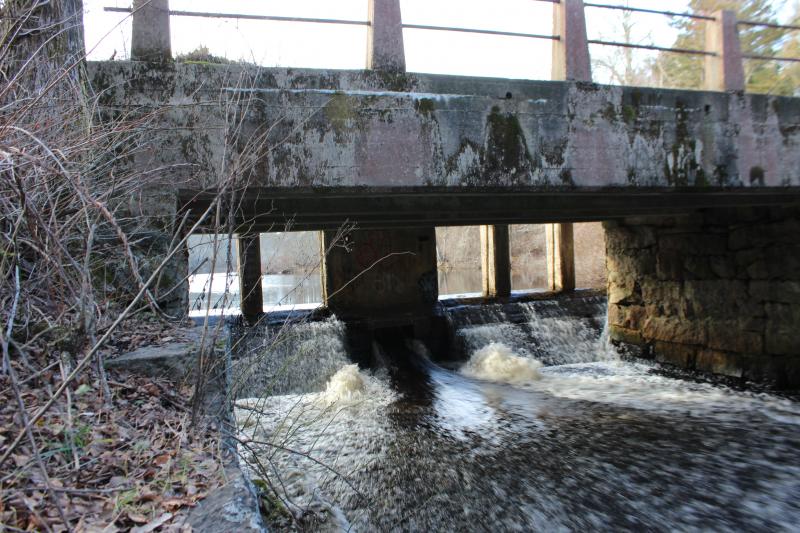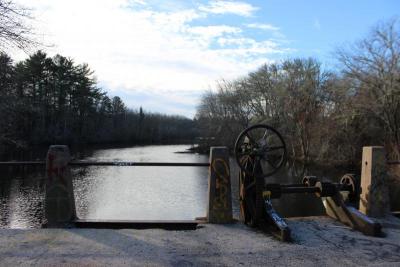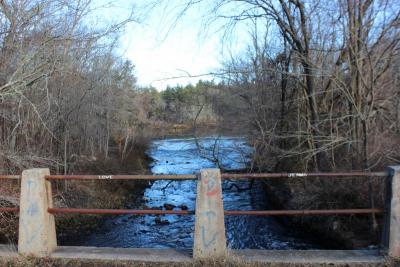Buzzards Bay Coalition hopes to bolster fish population on the Weweantic
As it stands, fish migrating upstream on the Weweantic River to spawn have a six-foot high dam blocking their way to Horseshoe Mill Pond.
As a result, a once massive population of herring and rainbow smelt has become non-existent.
But after obtaining $365,000 in grant money, the Buzzards Bay Coalition hopes that modifying or removing the dam will boost the fish population and return the area to its former, natural glory.
The Weweantic is the largest tributary to Buzzards Bay and the Horseshoe Mill area --where fresh water meets salt water -- and is one of the most important paths for spawning fish migration in the region. A crumbling, archaic dam, it was built in 1920 to redirect water to turbines that would power an old horseshoe factory, but it's proven to be an obstacle for fish migrating upstream.
"The bridge and the dam were once used to hold water back for the Horseshoe Mill," said Brendan Annett, vice president of watershed protection at the Buzzards Bay Coalition.
The Coalition purchased the land where the dam is located on Station Street for conservation in 2012.
"Now it's just crumbling into the river," Annett said, "and makes it impossible for fish to get through."
Currently, there is a small one-square-foot hole in the dam that allows for the passage of fish. Annett said when ice is melting and fish are spawning in the spring, the water rushes through the hole like a fire hose and makes it impossible for fish to travel upstream.
The mill's location makes it a prime location for numerous spawning fish such as rainbow smelt, herring, perch, American eels, and sea lampreys. There are also rare plants and wildlife that only exist in these unique intertidal locations.
The populations, however, are in steep decline or practically non-existent.
Annett said the Weweantic is the southernmost population point in the United States for Rainbow Smelt. Smelt have been fished in Wareham for centuries.
President Grover Cleveland loved fishing for Smelt in Wareham so much that he had legislation passed so he could dip net for smelt, according to Wareham historian Mack Phinney. That legislation is still in effect today, but smelt are practically non-existent in the waters of the Weweantic.
A few years ago, spawning rainbow smelt laid eggs in the millrace adjacent to the dam. Because of the location of the millrace channel, millions of eggs were left high and dry at low tide.
Annett said the state Division of Marine Fisheries and other organizations keep population counts for different species on the river, and both Rainbow Smelt and herring populations are virtually gone from the river.
The Coalition has been able to reverse this trend at a similar location in Acushnet. With the help of conservation groups, the Coalition removed a saw mill dam and replaced it with a series of fish ladders.
After the project's completion, the herring population on the Acushnet River jumped from 381 in 2007 to more than 10,000 traveling the river in 2014.
The Coalition was awarded a $365,000 grant in October from the Bouchard Oil Spill Trustee Council to explore ways to restore the fish population at Horseshoe Mill, including modifying or removing the dam.
Annett said the project is still in the early planning stages. Minor steps are being taken, such as mapping areas of the river and doing sediment testing, which help predict how things may change depending on what was done to the area.
He said it will be at least a few years until any project is completed. Keeping the area open, accessible and inviting to the public is also important to the project's organizers.
"We want people to come and go for a walk or go fishing," he said.
Restoring fish populations, attracting larger fish and wildlife, expanding the portion of the river where people can catch smelt and creating car top kayak and canoe launches are all potential benefits of the project.
"It's a place that is beautiful and no longer has any industrial use," Annett said. "We're interested in protecting that."













